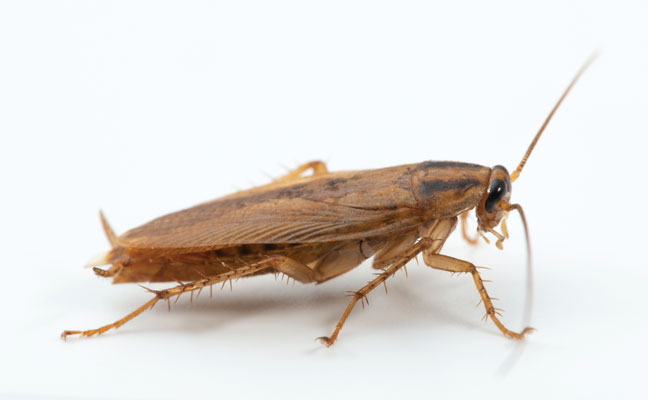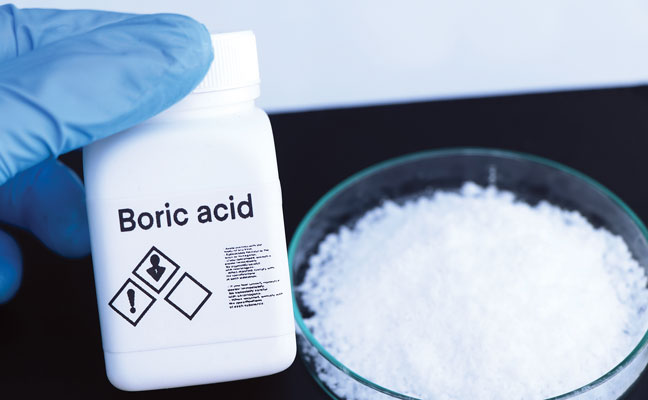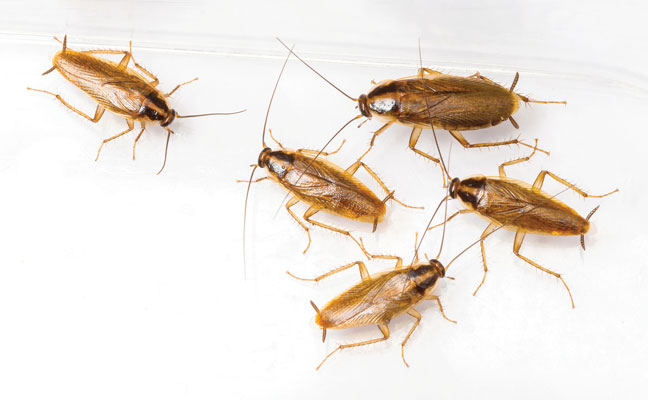
German cockroach resistance is nothing new, but it’s important to stay ahead of it. Photo: © Gene White
Pesticide resistance in insect pests, particularly the German cockroach (Blattella germanica), presents a significant challenge in the realm of pest management. Traditionally, research has focused on physiological resistance mechanisms, which encompass biochemical adaptations that enable insects to withstand pesticide exposure. These mechanisms involve alterations in target sites and enhanced detoxification processes (Terriere, 1983). However, recent attention has shifted toward behavioral resistance, where specific behavioral adaptations in certain individuals or populations lead to reduced exposure to lethal doses of insecticides.
The German cockroach is notorious for its adaptability and resilience, making it a formidable adversary for pest management professionals (PMPs). A holistic and strategic approach is essential, addressing both physiological and behavioral resistance. While physiological resistance mechanisms have been extensively studied, the emergence of behavioral resistance underscores the need for a more comprehensive understanding of the factors influencing insecticide efficacy.
Physiological resistance mechanisms
Several studies have delved into the molecular mechanisms underlying physiological resistance in German cockroaches. Soderlund and Bloomquist (1990) explored changes in target sites, detoxification processes, and the sequestration of toxic compounds as key adaptations to insecticides. Ahn et al. (1996) highlighted the role of detoxification enzymes in metabolizing and detoxifying pyrethroid insecticides. Scott and Matsumura (1989) reported target-site insensitivity affecting an insecticide’s binding affinity to the cockroach nervous system.
These studies provide valuable insights into physiological resistance mechanisms, laying the foundation for the development of effective pest management strategies. But they are only part of the puzzle.

Boric acid is one of several options to use in rotation against resistance. Photo: Kittisak Kaewchalun/iStock / Getty Images Plus/Getty Images
Behavioral resistance
In addition to physiological resistance, behavioral resistance has emerged as a pivotal factor impacting insecticide effectiveness. Hostetler and Brenner (1994) demonstrated that resistant strains of German cockroaches exhibited avoidance behavior toward insecticide-treated harborages, leading to higher mortality rates in susceptible strains. This aversion to insecticides and other food sources poses significant challenges in conventional treatment strategies.
The development of resistance within German cockroach populations poses numerous adverse consequences. Reduced insecticide effectiveness necessitates higher concentrations and more frequent treatments, escalating costs and potential environmental harm. Furthermore, when PMPs do not rotate pesticides at cockroach accounts, it contributes to the elimination of susceptible cockroaches only and allows the non-susceptible cockroaches to thrive and reproduce.
Rewriting rotating modes of action
One promising solution to combat resistance effectively is the implementation of rotating modes of action strategy. This approach involves strategically alternating chemical subgroups with unique modes of action during pest control efforts, minimizing selective pressure on specific resistance traits. To achieve comprehensive and sustainable management of resistance, implementing a quarterly rotation schedule that includes neonicotinoids, indoxacarb, avermectins and phenylpyrazoles/fiproles is recommended.
Using insecticide dust in voids and cracks
Implementing insecticide dust pesticides in voids, cracks and crevices can be a crucial element of a comprehensive pest management strategy. Carefully select insecticides that lack insect resistance to ensure effectiveness in these challenging areas, while prioritizing safety to avoid drift to non-target areas and prevent inhalation of dust. Among the highly effective options are borate, boric acid, and silica dust insecticides, each with unique mechanisms of action that make them powerful tools in pest control.

The German cockroach (Blattella germanica) is still the No. 1 species in volume and revenue for pest management professionals. (Source: PMP State of the Industry Report, November 2022) Photo: smuay/iStock / Getty Images Plus/Getty Images
Boric acid, known for its potency as an insecticide, exerts its effects through multiple modes of action, making it a formidable weapon against pests. By acting as a stomach poison, it effectively targets the gastrointestinal system of insects, leading to their demise. Furthermore, its potential toxic effects on the nervous system of insects add to its lethal action (Habes et al., 2005).
In addition to boric acid, borate salts present in our insecticides possess abrasive properties that prove detrimental to insect exoskeletons. This abrasive action effectively removes the protective film covering insects’ bodies, leaving them vulnerable to dehydration and ultimately causing their demise (WHO, 1998; Habes et al., 2005).
Silica gel, an amorphous form of silicon dioxide, also plays a critical role in pest control through a physical and desiccant-based approach (U.S. EPA, 1991). Its abrasive nature enables it to efficiently strip away the oily, protective film from insects’ bodies, causing them to dry out and perish. Notably, when cockroaches contact silica dust and inadvertently ingest it during grooming, the drying process is further accelerated, sealing their inevitable fate (U.S. EPA, 1991).
Employing insecticide dust with diverse modes of action, such as boric acid and silica gel, in voids and cracks as part of your comprehensive strategy can help combat pest infestations and significantly reduce the likelihood of resistance development (Habes et al., 2005; U.S. EPA, 1991).
REFERENCES
- Ahn, Y. J., Kwon, D. H., Lee, H. S., Lee, C. O., and Kim, J. H. (1996). Detoxification enzyme activity in a pyrethroid-resistant field strain of the German cockroach, Blattella germanica (L.). Pesticide Biochemistry and Physiology, 54(1), 18-26.
- Habes, D.; Morakchi, S.; Aribi, N.; Farine, J.P.; Soltani, N. Soltani Boric acid toxicity to the German cockroach, Blattella germanica: Alterations in midgut structure, and acetocholinesterase and glutathione S-transferase activity. Pestic. Biochem. Physiol. 2005, 84 (1),17-24.
- Hostetler, M. E. and Brenner, R. J. (1994). Behavioral and Physiological Resistance to Insecticides in the German Cockroach (Dictyoptera: Blattellidae): An Experimental Reevaluation. Journal of Economic Entomology, 87(4), 885-893.
- Silverman, J., and Ross, M. H. (1994). Behavioral Resistance of Field-Collected German Cockroaches (Blattodea: Blattellidae) to Baits Containing Glucose. Environmental Entomology, 23(2), 425-430.
- Soderlund, D. M., and Bloomquist, J. R. (1990). Molecular mechanisms of insecticide resistance. In R. T. Roush and B. E. Tabashnik (Eds.), Pesticide resistance in arthropods (pp. 58-96). Chapman and Hall, New York.
- Scott, J. G., and Matsumura, F. (1989). Insecticide resistance in the German cockroach, Blattella germanica. Neurotransmitter and Hormonal Mechanisms, 177-191.
- Terriere, L. C. (1983). Enzyme induction, gene amplification, and insect resistance to insecticides. In G. P. Georghiou and T. Saito (Eds.), Pest resistance to pesticides (pp. 265-298). Plenum Press, New York.
- United States Environmental Protection Agency (U.S. EPA). (1991). R.E.D. FACTS: Silicon Dioxide and Silica Gel. Pesticide Reregistration. Retrieved from www3.epa.gov/pesticides/chem_search/reg_actions/reregistration/fs_G-74_1-Sep-91.pdf
- WHO. Environmental Health Criteria 204: Boron; International Programme on Chemical Safety, World Health Organization: Geneva, Switzerland, 1998.
Leave A Comment